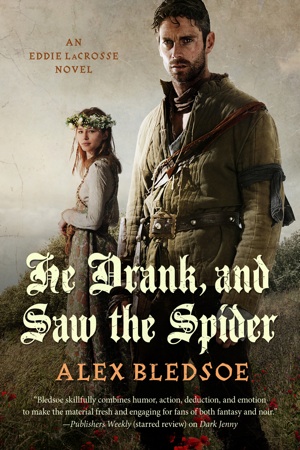Anyone who’s read a novel series knows that one of the pitfalls is repetition. After doing five, ten, even thirty books about a particular character or in a specific setting, it can be difficult to avoid repeating things. When I began the Eddie LaCrosse series, I wanted to avoid that particular pitfall.
I decided that each book would be based around a central concept or conceit that would (hopefully) give each novel a unique atmosphere and keep the series lively. The inspiration for the first novel, The Sword-Edged Blonde, was the song, “Rhiannon.” Burn Me Deadly encompassed everything I thought was cool about dragons. Dark Jenny adapted the Arthurian mythology to Eddie’s world. And Wake of the Bloody Angel…well, its inspiration can be described in one glorious word: pirates!
Which brings me to the latest in the series, He Drank, and Saw the Spider. This one can also be summed up in one two-syllable word, but it’s one of the biggest words in literature.
Shakespeare.
When I’m plotting out Eddie LaCrosse’s adventures, the process often starts with an idea like, “What if Eddie took the place of [insert character] in [insert famous work of literature]?” By the time I finish the manuscript, I’ve moved very far away from this initial inspiration, but it’s always there at the core. In the case of He Drank, and Saw the Spider, my thought was, “What if Eddie took the place of Autolycus in The Winter’s Tale?”
That particular play, one of Shakespeare’s last, is full of unique things. It has his longest single scene (about 45 minutes to an hour, depending on how it’s played), and his most famous stage direction: “Exit, pursued by a bear.” But that’s not where the strange things end.
The first three acts deal with the jealousy of King Leontes of Sicilia, who is convinced that his pregnant wife has been unfaithful with his best friend, Polixenes, king of Bohemia. He’s so irrationally hell-bent on proving her guilt that he ignores the Delphic Oracle’s assertion that she is honest, and sends his newborn daughter to her death. He eventually snaps out of it, but not before his wife and young son have also died. Unbeknowst to him, but knownst to us, his infant daughter Perdita has not been killed, only abandoned in Bohemia, where a kindly shepherd takes her in. This is all deadly serious stuff.
Then—gear shift! Sixteen years later we’re back in Bohemia, where Perdita, believing herself a shepherd’s daughter, is carrying on with Florizel, the son of Polixenes and heir to the throne. There is much dancing and singing, some dildo jokes (no, really) and, by the last scene, a delightfully ambiguous happy ending.
There’s also Autolycus, a traveling con man and scoundrel who pops up in Act IV and essentially takes over the rest of the play, enabling the resolution of the plot through his own selfish machinations. And that’s where my initial idea came from: what if Eddie was put into the same position in a similar plot?
The novel doesn’t stick slavishly to The Winter’s Tale by any means, no more than Burn Me Deadly copies the plot of one of its central inspirations, Mickey Spillane’s Kiss Me Deadly. Rather it was a starting point, a framework to build something unique on, much as (though obviously not on the same level) as Shakespeare used Robert Green’s Pandosto as a source for The Winter’s Tale.
So now you know the source. And on January 14, you can see how I did building He Drank, and Saw the Spider on some of the bare bones of The Winter’s Tale.
Read an excerpt from He Drank and Saw the Spider here on Tor.com
Alex Bledsoe is author of the Eddie LaCrosse novels (The Sword-Edged Blonde, Burn Me Deadly, Dark Jenny, Wake of the Bloody Angel, and the forthcoming He Drank, and Saw the Spider), the novels of the Memphis vampires (Blood Groove and The Girls with Games of Blood) and the Tufa novels (The Hum and the Shiver and Wisp of a Thing).










